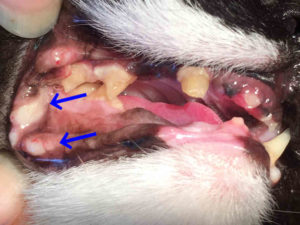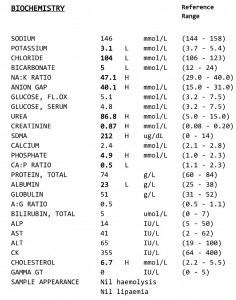Chronic kidney disease (CKD) is one of the most common health problems in cats, and is also regularly seen in dogs. Good treatment often means we can stabilise the disease so that your pet never suffers its consequences.
What Is Kidney Disease?
To know what happens when kidneys fail, you need to know what they do. They:
- Filter the blood of harmful waste such as urea and creatinine
- Maintain the correct levels of water and electrolytes (salts)
- Control the acid-base balance in the body
- Create hormones to make red blood cells and manage calcium levels
All of these go wrong in kidney failure.
What Does Kidney Disease Look Like?
Depending on the stage of kidney disease, symptoms include:
- Drinking and urinating more (the link gives other causes)
- Weight loss
- Poor appetite
- Lethargy and weakness
- Bad breath
- Vomiting
Of course, these are vague symptoms found in many diseases. The first step is an accurate diagnosis.
For dogs and cats to have the best quality of life and longer lifespans, we have developed protocols to manage this complex disease.
Diagnosis Of Kidney Problems
Chronic renal disease is one of the reasons we recommend annual routine screening blood tests. Kidney damage is often happening for months to years before an animal shows the signs. If we can detect it before too much kidney function is lost, your pet will have a much better prognosis.
Just documenting an elevated urea or creatinine level on a blood test is not enough. There are many other pre-renal and post-renal causes. To diagnose renal disease we also need:
A Physical Exam
The findings will depend on the stage of disease but, just as importantly, we should find no other explanations for the illness.
Blood Testing
In addition to Urea and Creatinine, we also see changes in SDMA, Phosphate, Calcium, Potassium, Bicarbonate, Albumin, Globulins and markers of anaemia, depending on the patient. The blood test shown here is from a severely affected cat.
Urine Testing
We need a routine urine analysis in order to show inappropriately dilute urine (if the urine is concentrated normally, it’s almost certainly not renal failure). We also need a protein:creatinine ratio (to look for protein loss) and to send a sterile sample for bacterial culture (infection is a very common hidden cause).
Read how to collect urine from dogs & cats here.
Ultrasound & X-rays
Imaging of the kidneys is not routine but done when there are abnormalities in size and shape of the kidneys or when we suspect kidney stones
Blood Pressure Measurement
Hypertension is very commonly linked with kidney disease. It’s essential to control high blood pressure to less than 160 mmHg to slow down the disease, and prevent sudden blindness especially in cats.
Monitoring
Things change and we’ll certainly want to follow up your cat or dog regularly to avoid nasty surprises.
Staging of CKD for treatment
Here are general guidelines on how we treat chronic kidney disease. In every case, these need to be tailored to the individual patient. Especially with cats, sometimes more treatment is not better treatment, especially if it causes a pet to go off their food.
At Risk Of CKD
Features:
- Creatinine < 0.125 mmol/l (dogs) or < 0.14 mmol/l (cats)
- Family history
- Normal blood test results with suspicion of future kidney problems due to:
- Exposure to kidney toxins (ibuprofen, lilies, antifreeze)
- Age
- Congenital conditions like polycystic renal disease (check your cat’s genetic diseases here)
Treatment: None. Close monitoring recommended.
Stage 1 CKD
Features:
- Creatinine < 0.125 mmol/l (dogs) or < 0.14 mmol/l (cats)
- Poorly concentrated urine and excessive thirst (non-renal causes eliminated)
- Normal blood test results plus another abnormality such as:
- Excessive urine protein
- Abnormal kidney shape or size
- Abnormal kidney biopsy
- Increasing blood values over time
- A persistent SDMA above 14 μg/dl despite normal creatinine values
Treatment:
- Remove any treatments potentially harmful to the kidney
- Treat any other concurrent illnesses
- Investigate for contributing causes like urinary stones or infections
- Make sure fresh water is available at all times
- Correct dehydration promptly
- Investigate & treat proteinuria or hypertension
- Start a clinical renal diet? If plasma phosphate is between 0.9 & 1.5 mmol/l and there’s no proteinuria, it’s not necessary. However, these diets are very important for Stages 2 & 3 so it may be best to introduce them while your pet still has a good appetite.
Stage 2 CKD
Features:
- Creatinine 0.125 – 0.18 mmol/l (dogs) or 0.14 – 0.25 mmol/l (cats)
- Mildly elevated renal parameters (called azotaemia)
- Drinking more water
- Few or no signs of illness other than:
- Urinating more dilute urine
- Low body weight & SDMA ≥25 μg/dl may indicate the degree of renal dysfunction has been underestimated. Consider treatment recommendations listed under Stage 3 in this case.
Treatment:
- Everything for Stage 1 plus:
- Start clinical renal diet if not already done
- Maintain a plasma phosphate concentration between 0.9 & 1.5 mmol/l (dietary phosphate binders may be necessary)
- Fluid therapy, often initially in hospital
Stage 3 CKD
Features:
- Creatinine 0.181 – 0.44 mmol/l (dogs) or 0.251 – 0.44 mmol/l (cats)
- Moderate azotaemia
- Other blood values often also abnormal (eg. Phosphate, Calcium)
- Weight loss
- Clear signs of illness such as:
- Poor appetite
- Excessive drinking & urinating
- Vomiting
- Lethargy
- Low body weight & SDMA ≥45 μg/dl may indicate the degree of renal dysfunction has been underestimated. Consider treatment recommendations listed under Stage 4 in this case.
Treatment:
- Everything for Stages 1 & 2 plus:
- Anaemia management
- Nausea and vomiting control
- Home fluid therapy
- Adjust doses of any drugs cleared by the kidney
Stage 4 CKD

Features:
- Creatinine > 0.44 mmol/l (dogs & cats)
- Severe azotaemia
- Mouth ulcers
- Multiple signs of illness. These include all of the above plus:
- Bad breath
- Persistent Dehydration
Treatment:
- Everything for Stages 1,2 & 3, more intensively
- Read our guide to getting sick cats to eat
- Consider advisability of further treatment if quality of life poor
- Renal transplantation is very rarely a practical option
When To Euthanase
If your dog or cat stops eating, and the vet has tried everything, it’s time to make the kindest decision. Dogs and cats dying of kidney failure linger for days to weeks and probably suffer terribly. They won’t complain so it’s up to us to help them go at the right time.
If these thoughts are upsetting or scary, we hope our guide to pet euthanasia will help ease your fears. No one wants to regret holding on for too long. We’re always ready to offer our compassionate advice if you’re unsure what to do.

